2005 LINCOLN TOWN CAR jump start
[x] Cancel search: jump startPage 2 of 328
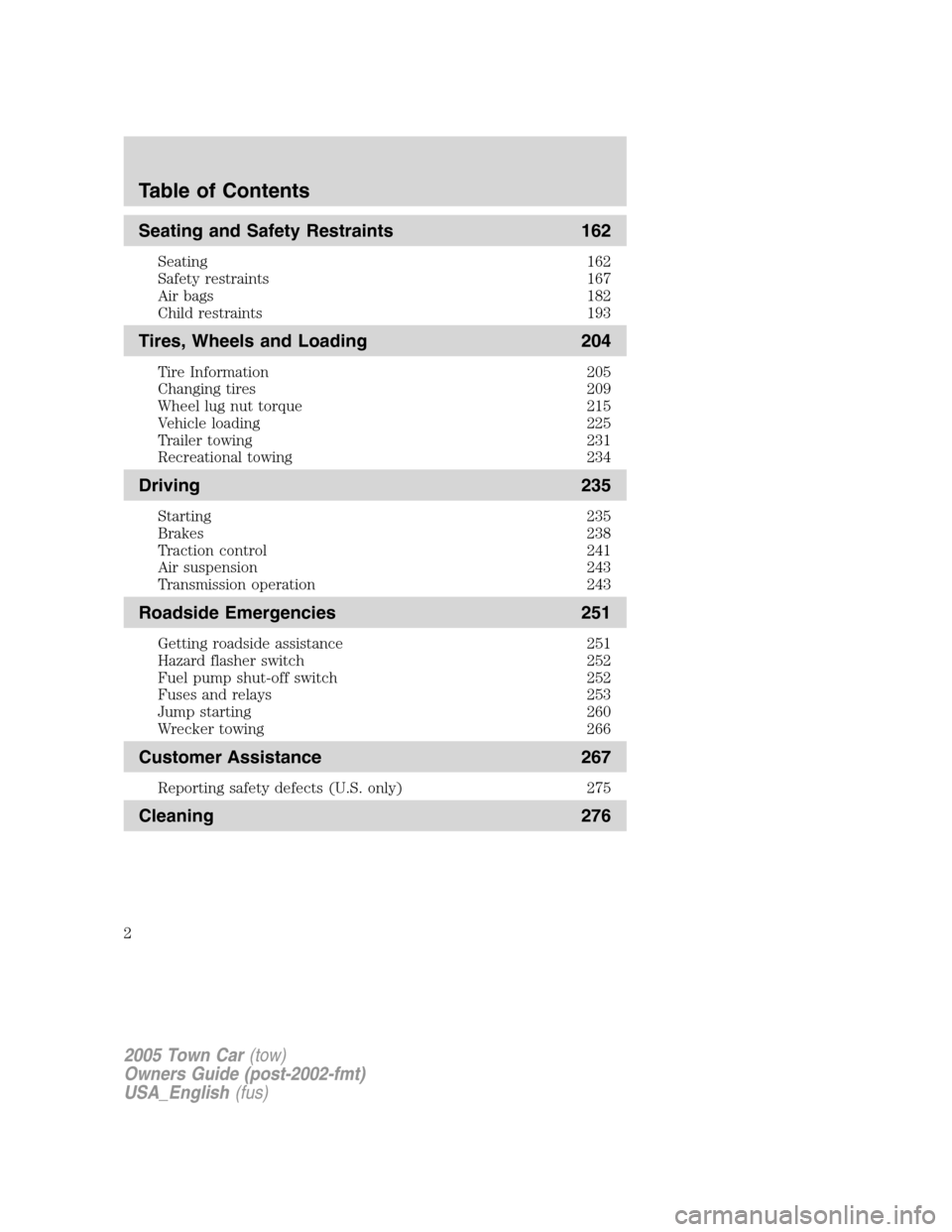
Seating and Safety Restraints 162
Seating 162
Safety restraints 167
Air bags 182
Child restraints 193
Tires, Wheels and Loading 204
Tire Information 205
Changing tires 209
Wheel lug nut torque 215
Vehicle loading 225
Trailer towing 231
Recreational towing 234
Driving 235
Starting 235
Brakes 238
Traction control 241
Air suspension 243
Transmission operation 243
Roadside Emergencies 251
Getting roadside assistance 251
Hazard flasher switch 252
Fuel pump shut-off switch 252
Fuses and relays 253
Jump starting 260
Wrecker towing 266
Customer Assistance 267
Reporting safety defects (U.S. only) 275
Cleaning 276
Table of Contents
2
2005 Town Car(tow)
Owners Guide (post-2002-fmt)
USA_English(fus)
Page 251 of 328
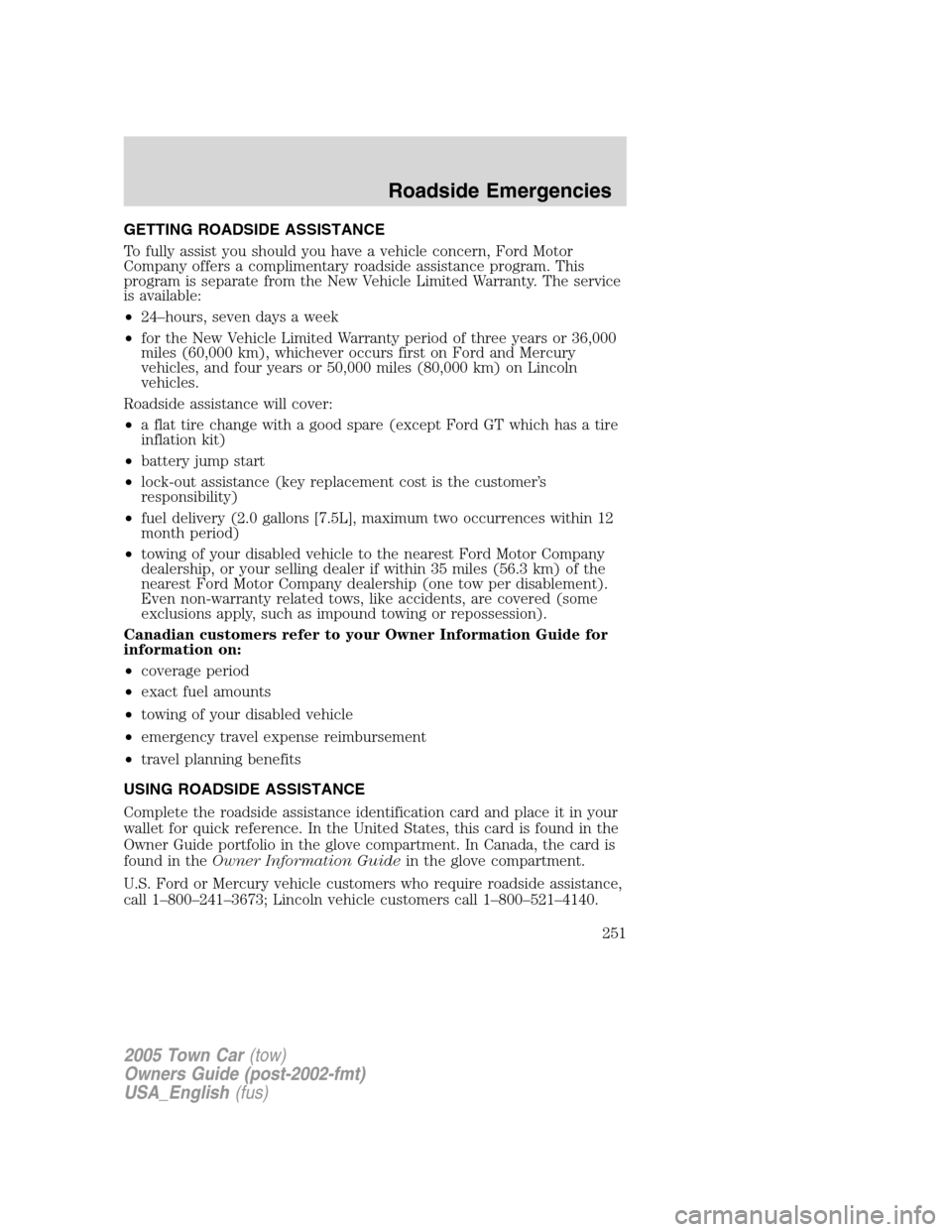
GETTING ROADSIDE ASSISTANCE
To fully assist you should you have a vehicle concern, Ford Motor
Company offers a complimentary roadside assistance program. This
program is separate from the New Vehicle Limited Warranty. The service
is available:
•24–hours, seven days a week
•for the New Vehicle Limited Warranty period of three years or 36,000
miles (60,000 km), whichever occurs first on Ford and Mercury
vehicles, and four years or 50,000 miles (80,000 km) on Lincoln
vehicles.
Roadside assistance will cover:
•a flat tire change with a good spare (except Ford GT which has a tire
inflation kit)
•battery jump start
•lock-out assistance (key replacement cost is the customer’s
responsibility)
•fuel delivery (2.0 gallons [7.5L], maximum two occurrences within 12
month period)
•towing of your disabled vehicle to the nearest Ford Motor Company
dealership, or your selling dealer if within 35 miles (56.3 km) of the
nearest Ford Motor Company dealership (one tow per disablement).
Even non-warranty related tows, like accidents, are covered (some
exclusions apply, such as impound towing or repossession).
Canadian customers refer to your Owner Information Guide for
information on:
•coverage period
•exact fuel amounts
•towing of your disabled vehicle
•emergency travel expense reimbursement
•travel planning benefits
USING ROADSIDE ASSISTANCE
Complete the roadside assistance identification card and place it in your
wallet for quick reference. In the United States, this card is found in the
Owner Guide portfolio in the glove compartment. In Canada, the card is
found in theOwner Information Guidein the glove compartment.
U.S. Ford or Mercury vehicle customers who require roadside assistance,
call 1–800–241–3673; Lincoln vehicle customers call 1–800–521–4140.
2005 Town Car(tow)
Owners Guide (post-2002-fmt)
USA_English(fus)
Roadside Emergencies
251
Page 260 of 328
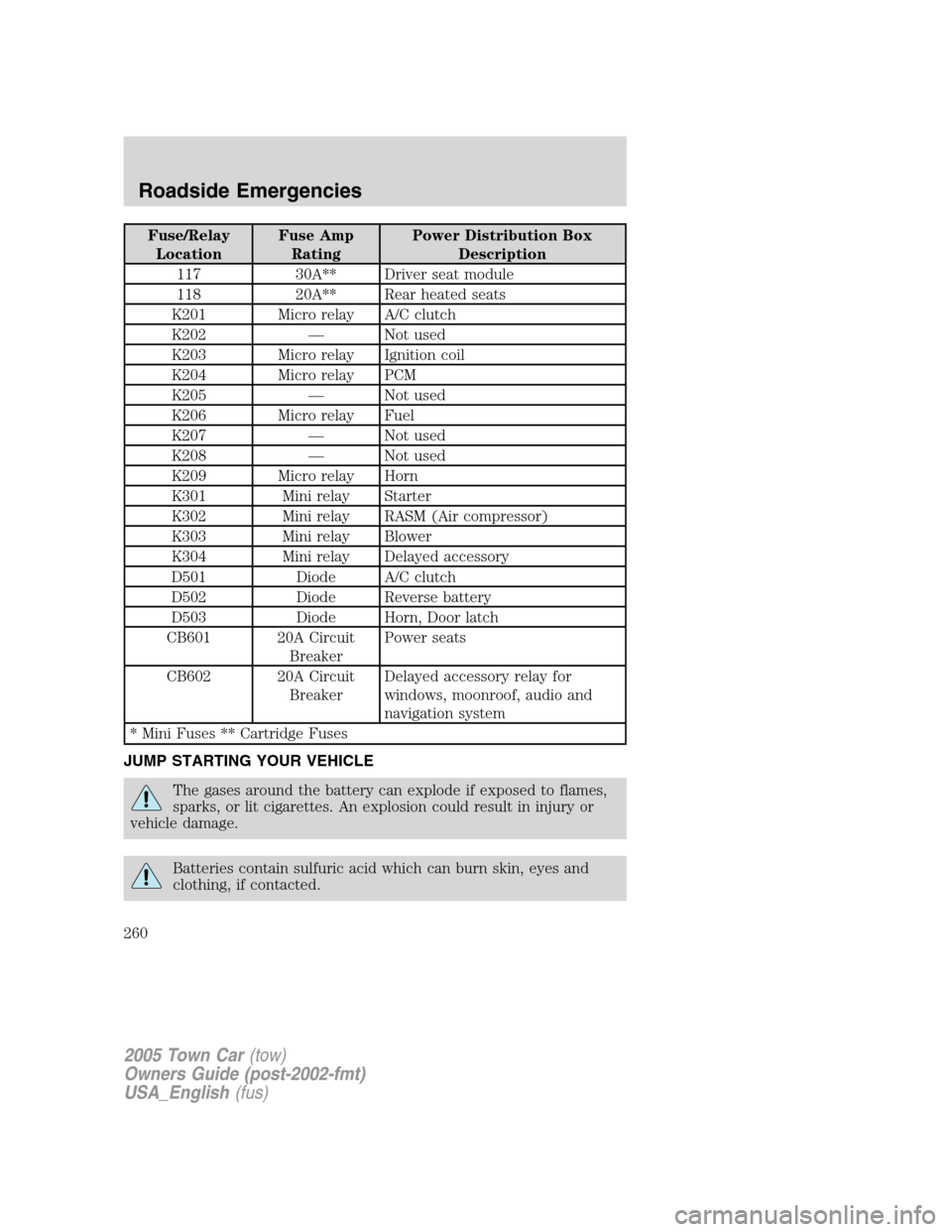
Fuse/Relay
LocationFuse Amp
RatingPower Distribution Box
Description
117 30A** Driver seat module
118 20A** Rear heated seats
K201 Micro relay A/C clutch
K202 — Not used
K203 Micro relay Ignition coil
K204 Micro relay PCM
K205 — Not used
K206 Micro relay Fuel
K207 — Not used
K208 — Not used
K209 Micro relay Horn
K301 Mini relay Starter
K302 Mini relay RASM (Air compressor)
K303 Mini relay Blower
K304 Mini relay Delayed accessory
D501 Diode A/C clutch
D502 Diode Reverse battery
D503 Diode Horn, Door latch
CB601 20A Circuit
BreakerPower seats
CB602 20A Circuit
BreakerDelayed accessory relay for
windows, moonroof, audio and
navigation system
* Mini Fuses ** Cartridge Fuses
JUMP STARTING YOUR VEHICLE
The gases around the battery can explode if exposed to flames,
sparks, or lit cigarettes. An explosion could result in injury or
vehicle damage.
Batteries contain sulfuric acid which can burn skin, eyes and
clothing, if contacted.
2005 Town Car(tow)
Owners Guide (post-2002-fmt)
USA_English(fus)
Roadside Emergencies
260
Page 261 of 328
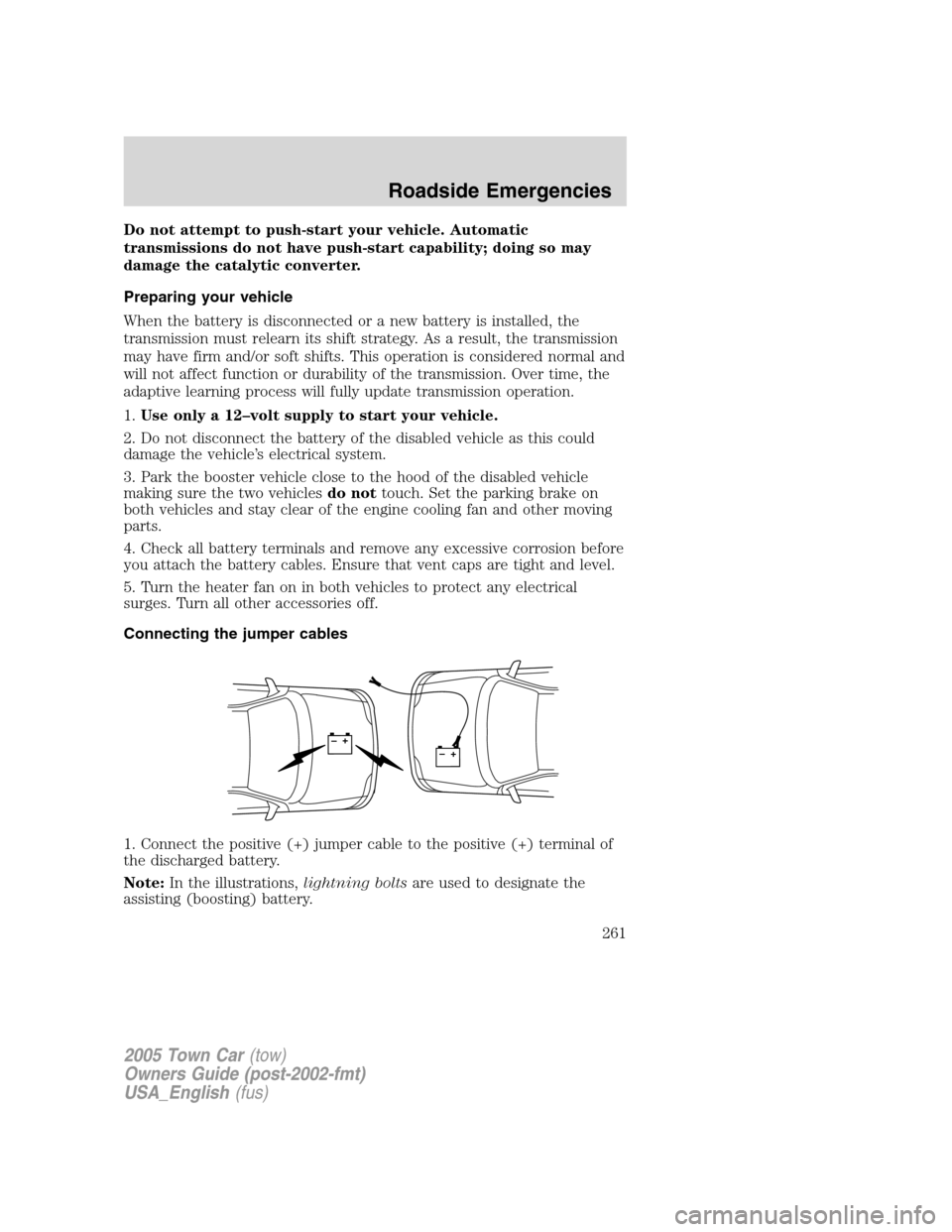
Do not attempt to push-start your vehicle. Automatic
transmissions do not have push-start capability; doing so may
damage the catalytic converter.
Preparing your vehicle
When the battery is disconnected or a new battery is installed, the
transmission must relearn its shift strategy. As a result, the transmission
may have firm and/or soft shifts. This operation is considered normal and
will not affect function or durability of the transmission. Over time, the
adaptive learning process will fully update transmission operation.
1.Use only a 12–volt supply to start your vehicle.
2. Do not disconnect the battery of the disabled vehicle as this could
damage the vehicle’s electrical system.
3. Park the booster vehicle close to the hood of the disabled vehicle
making sure the two vehiclesdo nottouch. Set the parking brake on
both vehicles and stay clear of the engine cooling fan and other moving
parts.
4. Check all battery terminals and remove any excessive corrosion before
you attach the battery cables. Ensure that vent caps are tight and level.
5. Turn the heater fan on in both vehicles to protect any electrical
surges. Turn all other accessories off.
Connecting the jumper cables
1. Connect the positive (+) jumper cable to the positive (+) terminal of
the discharged battery.
Note:In the illustrations,lightning boltsare used to designate the
assisting (boosting) battery.
+–+–
2005 Town Car(tow)
Owners Guide (post-2002-fmt)
USA_English(fus)
Roadside Emergencies
261
Page 263 of 328
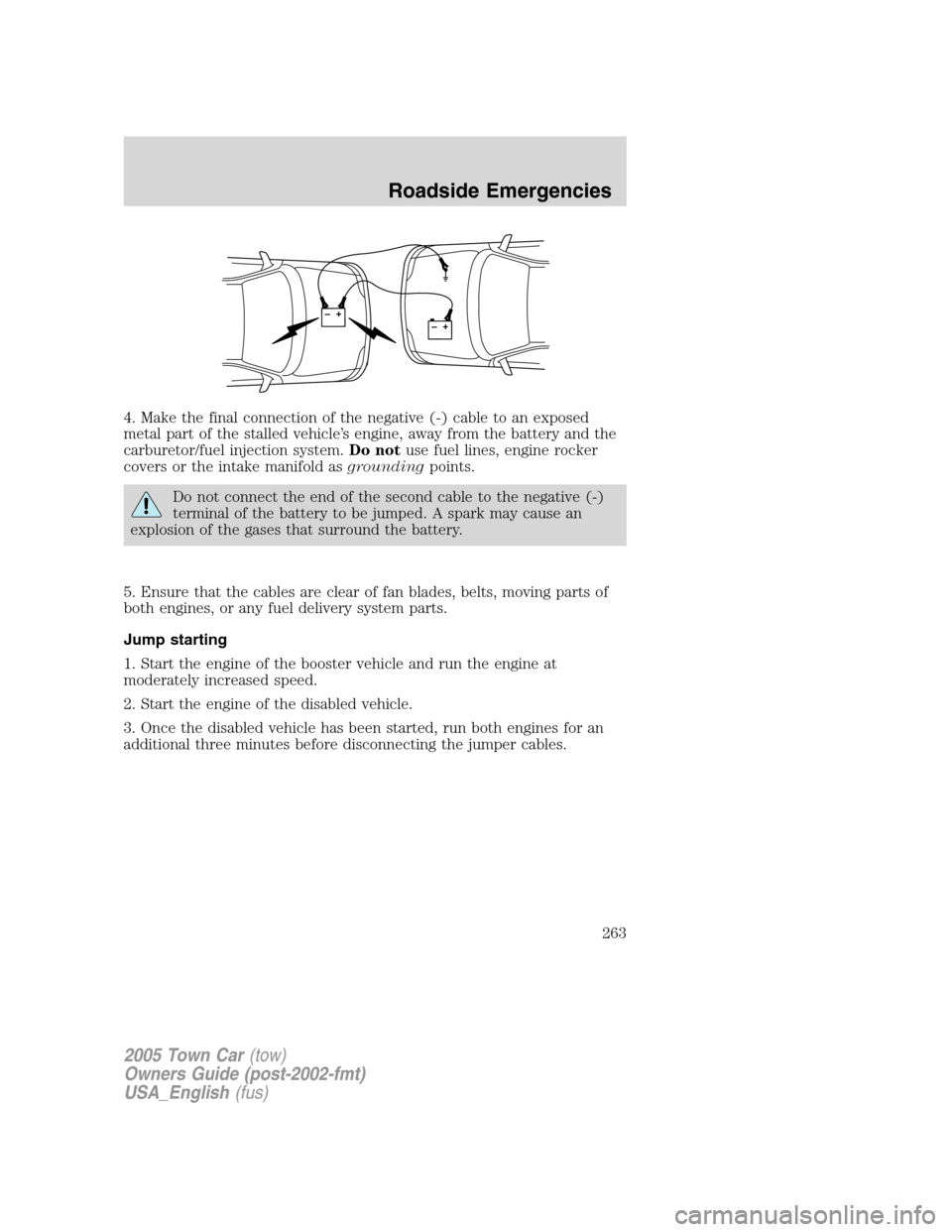
4. Make the final connection of the negative (-) cable to an exposed
metal part of the stalled vehicle’s engine, away from the battery and the
carburetor/fuel injection system.Do notuse fuel lines, engine rocker
covers or the intake manifold asgroundingpoints.
Do not connect the end of the second cable to the negative (-)
terminal of the battery to be jumped. A spark may cause an
explosion of the gases that surround the battery.
5. Ensure that the cables are clear of fan blades, belts, moving parts of
both engines, or any fuel delivery system parts.
Jump starting
1. Start the engine of the booster vehicle and run the engine at
moderately increased speed.
2. Start the engine of the disabled vehicle.
3. Once the disabled vehicle has been started, run both engines for an
additional three minutes before disconnecting the jumper cables.
+–+–
2005 Town Car(tow)
Owners Guide (post-2002-fmt)
USA_English(fus)
Roadside Emergencies
263
Page 265 of 328
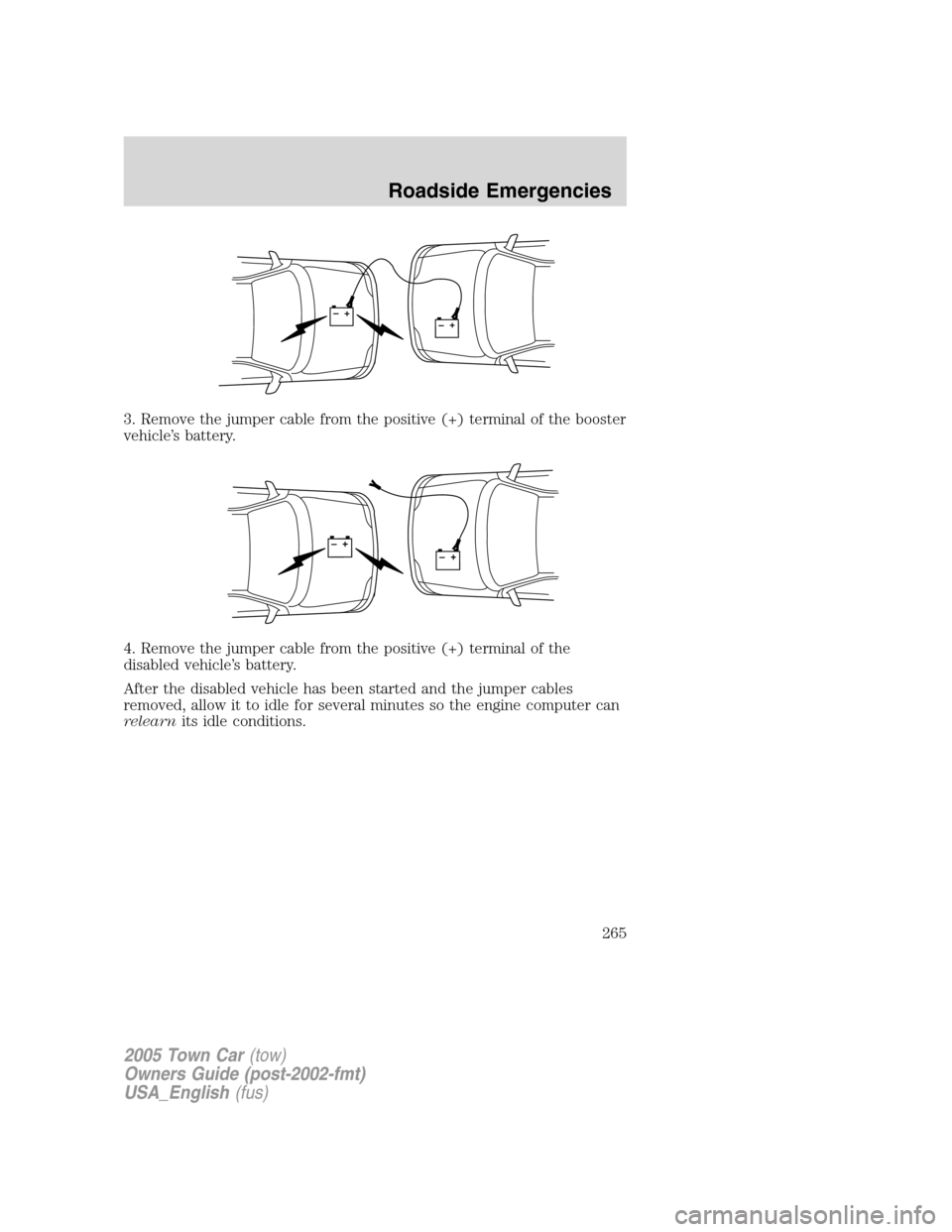
3. Remove the jumper cable from the positive (+) terminal of the booster
vehicle’s battery.
4. Remove the jumper cable from the positive (+) terminal of the
disabled vehicle’s battery.
After the disabled vehicle has been started and the jumper cables
removed, allow it to idle for several minutes so the engine computer can
relearnits idle conditions.
+–+–
+–+–
2005 Town Car(tow)
Owners Guide (post-2002-fmt)
USA_English(fus)
Roadside Emergencies
265
Page 324 of 328
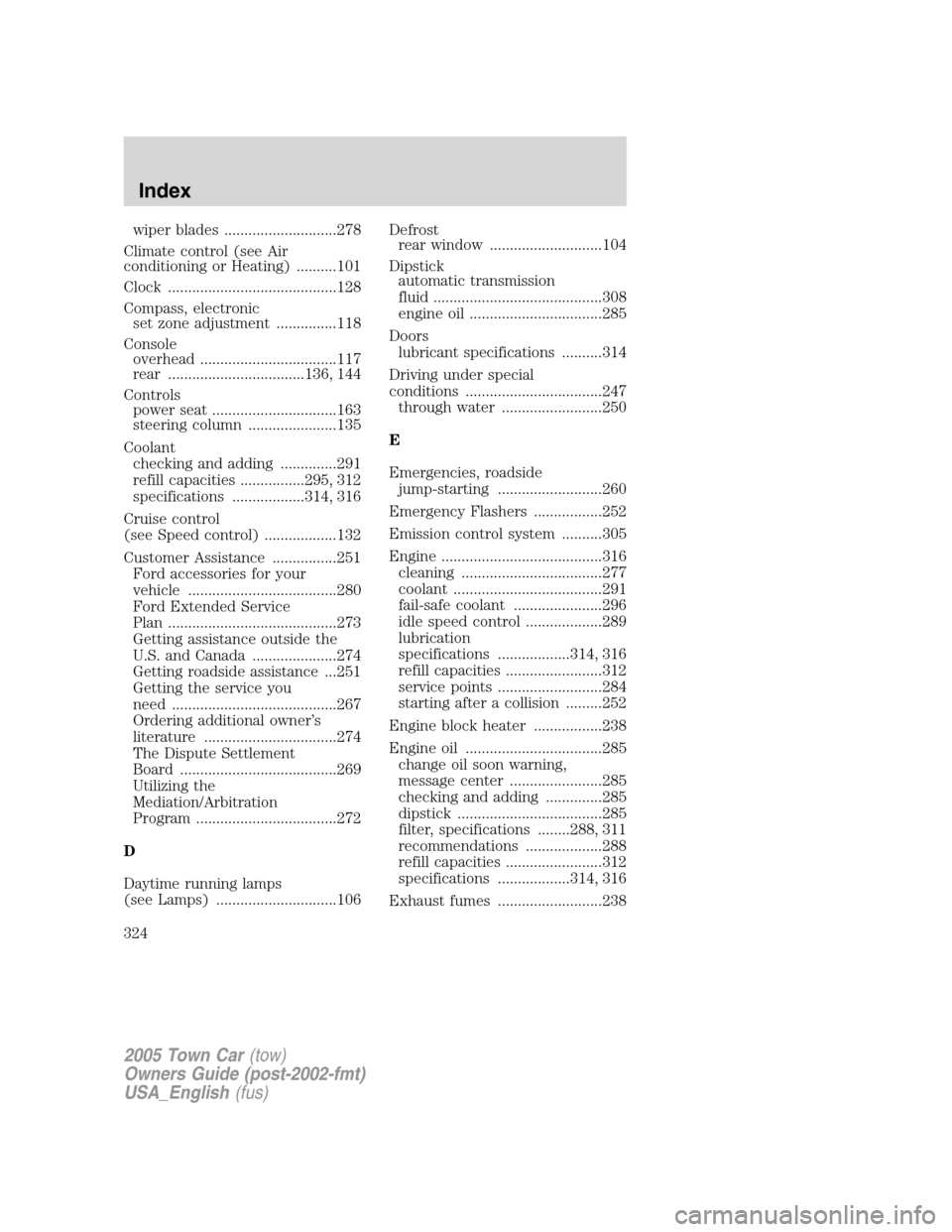
wiper blades ............................278
Climate control (see Air
conditioning or Heating) ..........101
Clock ..........................................128
Compass, electronic
set zone adjustment ...............118
Console
overhead ..................................117
rear ..................................136, 144
Controls
power seat ...............................163
steering column ......................135
Coolant
checking and adding ..............291
refill capacities ................295, 312
specifications ..................314, 316
Cruise control
(see Speed control) ..................132
Customer Assistance ................251
Ford accessories for your
vehicle .....................................280
Ford Extended Service
Plan ..........................................273
Getting assistance outside the
U.S. and Canada .....................274
Getting roadside assistance ...251
Getting the service you
need .........................................267
Ordering additional owner’s
literature .................................274
The Dispute Settlement
Board .......................................269
Utilizing the
Mediation/Arbitration
Program ...................................272
D
Daytime running lamps
(see Lamps) ..............................106Defrost
rear window ............................104
Dipstick
automatic transmission
fluid ..........................................308
engine oil .................................285
Doors
lubricant specifications ..........314
Driving under special
conditions ..................................247
through water .........................250
E
Emergencies, roadside
jump-starting ..........................260
Emergency Flashers .................252
Emission control system ..........305
Engine ........................................316
cleaning ...................................277
coolant .....................................291
fail-safe coolant ......................296
idle speed control ...................289
lubrication
specifications ..................314, 316
refill capacities ........................312
service points ..........................284
starting after a collision .........252
Engine block heater .................238
Engine oil ..................................285
change oil soon warning,
message center .......................285
checking and adding ..............285
dipstick ....................................285
filter, specifications ........288, 311
recommendations ...................288
refill capacities ........................312
specifications ..................314, 316
Exhaust fumes ..........................238
2005 Town Car(tow)
Owners Guide (post-2002-fmt)
USA_English(fus)
Index
324
Page 325 of 328
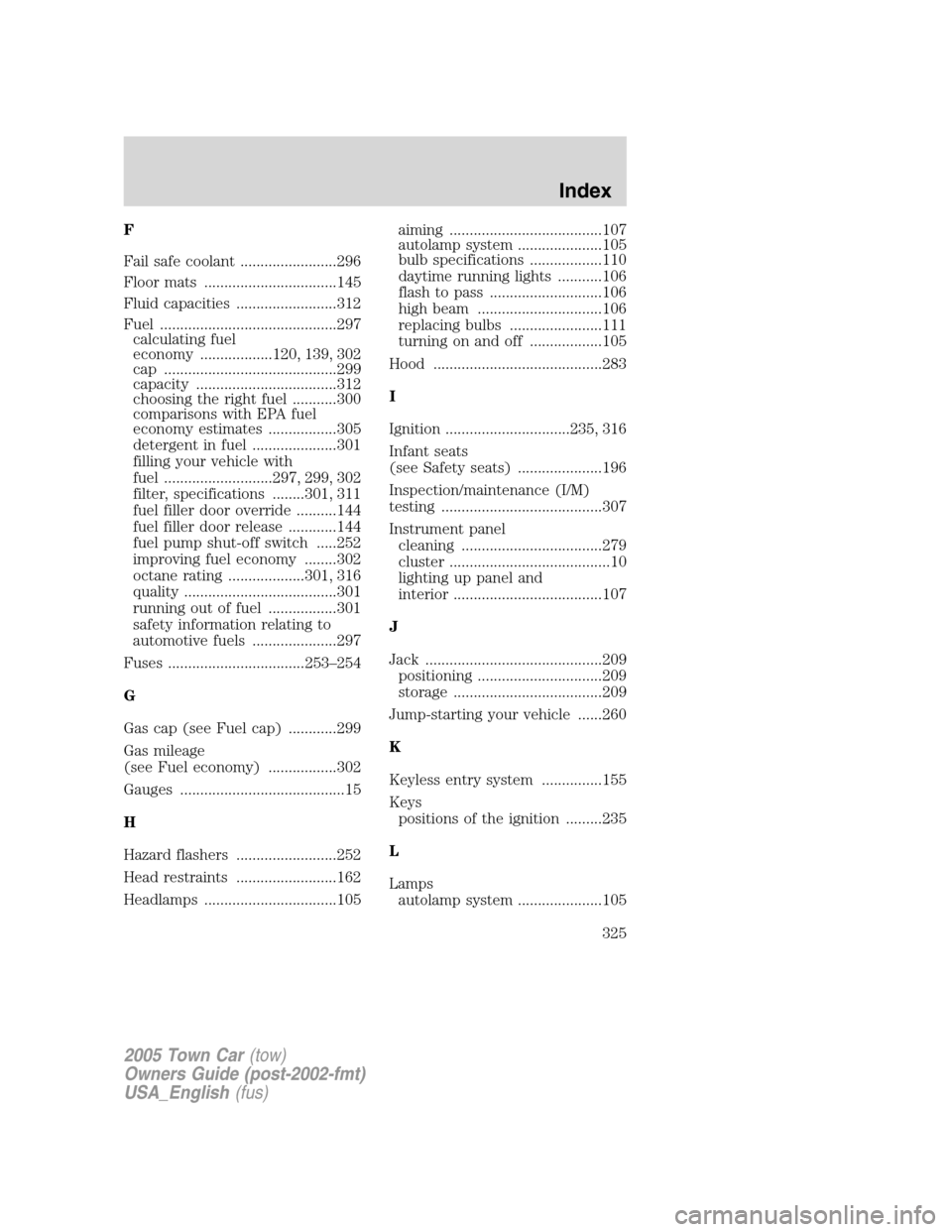
F
Fail safe coolant ........................296
Floor mats .................................145
Fluid capacities .........................312
Fuel ............................................297
calculating fuel
economy ..................120, 139, 302
cap ...........................................299
capacity ...................................312
choosing the right fuel ...........300
comparisons with EPA fuel
economy estimates .................305
detergent in fuel .....................301
filling your vehicle with
fuel ...........................297, 299, 302
filter, specifications ........301, 311
fuel filler door override ..........144
fuel filler door release ............144
fuel pump shut-off switch .....252
improving fuel economy ........302
octane rating ...................301, 316
quality ......................................301
running out of fuel .................301
safety information relating to
automotive fuels .....................297
Fuses ..................................253–254
G
Gas cap (see Fuel cap) ............299
Gas mileage
(see Fuel economy) .................302
Gauges .........................................15
H
Hazard flashers .........................252
Head restraints .........................162
Headlamps .................................105aiming ......................................107
autolamp system .....................105
bulb specifications ..................110
daytime running lights ...........106
flash to pass ............................106
high beam ...............................106
replacing bulbs .......................111
turning on and off ..................105
Hood ..........................................283
I
Ignition ...............................235, 316
Infant seats
(see Safety seats) .....................196
Inspection/maintenance (I/M)
testing ........................................307
Instrument panel
cleaning ...................................279
cluster ........................................10
lighting up panel and
interior .....................................107
J
Jack ............................................209
positioning ...............................209
storage .....................................209
Jump-starting your vehicle ......260
K
Keyless entry system ...............155
Keys
positions of the ignition .........235
L
Lamps
autolamp system .....................105
2005 Town Car(tow)
Owners Guide (post-2002-fmt)
USA_English(fus)
Index
325